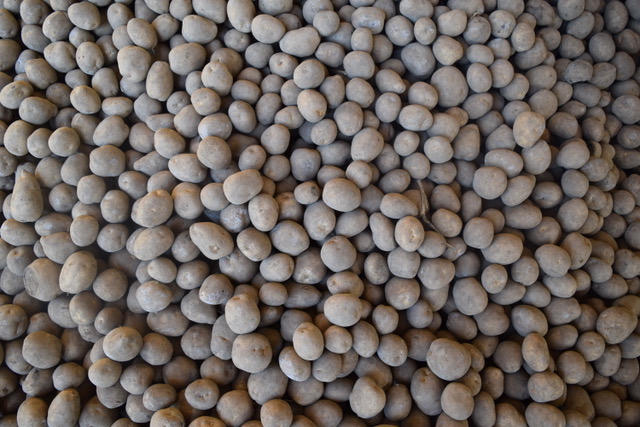
Why decoding the genome matters
Researchers from the Ludwig Maximilian University of Munich and the Max Planck Institute for Plant Breeding Research in Cologne, Germany, have completely deciphered the highly complex genome of the potato for the first time. Complete sequencing of the potato’s genetic material could open doors in terms of breeding better varieties.
Potato breeding is not a straightforward endeavour. What makes it so complicated is that potatoes are tetraploids, which means each plant inherits a copy of every one of both its mother’s and father’s chromosomes. The resulting plant has four copies of each chromosome; its genome comprises more than 39,000 protein-coding genes. Not only does this make breeding challenging, but it also made reconstructing the potato genome particularly difficult. It was, in fact, more challenging than reconstructing the human genome.
To tackle this challenge, Korbinian Schneeberger, geneticist at Ludwig-Maximilians-Universität München in Germany, his colleague Hequan Sun and their coworkers sequenced the DNA of a number of individual pollen cells. They found this to be the easier route since each pollen cell contains just two random copies of each chromosome.
Using this information, breeders were able to identify which genes are responsible for individual traits, including those both desirable and undesirable. The approach also allows for gene isolation, which means molecular geneticists can use candidate genes for trait gene discovery — the process by which breeders identify which genes contribute to the development of a trait or phenotype. But perhaps most importantly, this new methodology shortens the time it takes to breed new varieties and helps to reduce the overall cost of breeding new varieties.
“Building on this work, we can now implement genome-assisted breeding of new potato varieties that will be more productive and also resistant to climate change,” said Schneeberger. “This could have a huge impact on delivering food security in the decades to come.”
The potato is a staple in many diets around the world, and while efforts to boost yield and resiliency have been made, little improvement has been made over the years. The Irish potato famine of the 1840s is a good example of what can happen when disease strikes a crop that shows very little diversity. But it takes, on average, 10-12 years to bring each new variety to market, as breeders can only make one selection per year. There is also a high risk of tuber-borne disease transmission at each selection stage.
In fact, breeders say it takes beyond the fourth field year to reliably assess tuber yield performance. This is because of an extremely low multiplication rate of less than 15 tubers per plant. The first years are, for the most part, dedicated to tuber production for the purpose of testing. Until now, there was nothing breeders could do to speed up that process.
The benefits of completely sequencing the potato’s genetic material are many. Not only will it accelerate the breeding of more robust varieties, enhancing global food security, but it will help to diversify the staple crop, making it less susceptible to disease pressure. In the US, diseases of note include: late blight, common scab, silver scurf and rhizoctonia, potato virus Y (PVY), potato mop-top virus (PMTV) and zebra chip.
Breeders are looking for more than resistance to disease, though. In potatoes for processing, for instance, they’re breeding for starch content, friability, color, taste and length. For the fresh market, breeders look for taste, skin, color and consumer appeal when developing new cultivars.
Agronomically speaking, most breeders are looking for high-yielding, high quality, stable varieties that are resilient to pests and climatic variation. Resilience under extreme weather conditions will be particularly important as climate change continues to throw curveballs in producers’ paths.
In the Oregon and Northwest potato industry, the traits of importance are: low solids, early maturity, bruise resistance, disease and pest tolerance, superior taste, long-term storage, high yields and long dormancy. The main objective of the Oregon Potato Breeding Program is to develop new russet potatoes for the fresh market and processing industry. In particular, they’re looking to develop varieties with increased tolerance to soilborne pathogens.
Similarly, the Colorado Potato Breeding and Selection Program’s main objectives are to develop new potato cultivars with increased yield, improved quality, improved nutritional and health characteristics, resistance to diseases and pests, and tolerance to environmental stresses. They, too, put emphasis on the development of russet cultivars.
At Michigan State University, breeders are working to optimize conventional breeding techniques for varietal selection and to develop improved breeding methods in order to develop better varieties for the state’s potato industry, which is heavily focused on chipping potatoes. MSU’s breeding program, among other goals, puts emphasis on improving storability and conferring resistance to Colorado potato beetle, as well as diseases such as late blight, scab, wart disease and nematodes. They hope to integrate transformation and gene-editing techniques into their breeding program, particularly for economically important traits.
The complete sequencing of the potato’s genetic material takes all of these breeding programs one step closer to reaching their goals.














